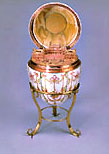Faberge Imperial Easter Eggs
www.Gatchino.com/Jeweller/Faberge/

FabergeImperialEasterEggs
»мператорские пасхальные €йца ‘аберже
The Gatchina Palace Egg
яйцо «√атчинский дворец»
ќсобенности реставрации
Features of restoration

 Continuing a practice initiated by his father, Alexander III, Czar
Nicholas II (1868-1918) presented this egg to his mother, Maria Feodorovna,
on Easter Day in 1901. Faberge's revival of 18th-century techniques,
including the application of multiple layers of translucent enamel over
guilloche or mechanically engraved gold, is demonstrated in the shell
of the egg. When opened, the egg reveals a miniature replica of the
Gatchina Palace, the Dowager Empress's principle residence outside St.
Petersburg. So meticulously did Faberge's workmaster, Mikhail Perkhin,
execute the palace that one can discern such details as cannons, a flag,
a statue of Paul I (1754-1801), and elements of the landscape, including
parterres and trees.
Continuing a practice initiated by his father, Alexander III, Czar
Nicholas II (1868-1918) presented this egg to his mother, Maria Feodorovna,
on Easter Day in 1901. Faberge's revival of 18th-century techniques,
including the application of multiple layers of translucent enamel over
guilloche or mechanically engraved gold, is demonstrated in the shell
of the egg. When opened, the egg reveals a miniature replica of the
Gatchina Palace, the Dowager Empress's principle residence outside St.
Petersburg. So meticulously did Faberge's workmaster, Mikhail Perkhin,
execute the palace that one can discern such details as cannons, a flag,
a statue of Paul I (1754-1801), and elements of the landscape, including
parterres and trees.

Carl Faberge, French, 1846-1920
Mikhail Perkhin, Russian, St. Petersburg, active 1884-1903
1901
Gold, enamel, seed pearls
Height: 5 in.
Acquired by Henry Walters, 1930
Although objects from the Faberge workshop are prized for their meticulous workmanship and beautiful effect, the materials of manufacture are not always as precious as they seem. This can lead to cleaning and restoration problems. As with many Faberge objects, the variety of gold tones on the Gatchina Palace Egg is not created with solid gold, but is actually the result of washing various compositions of gold over another metal, perhaps silver. When the Egg was brought to the conservation labs, the gold palace was covered in tarnish due to corrosion of the underlying metal. In order to remove the tarnish without removing the delicate gold washes, the conservators used a chemical reagent, rather than an abrasive technique, painstakingly to restore the Gatchina Palace Egg to its original beauty.
copyright © 2001 The Walters Art Museum